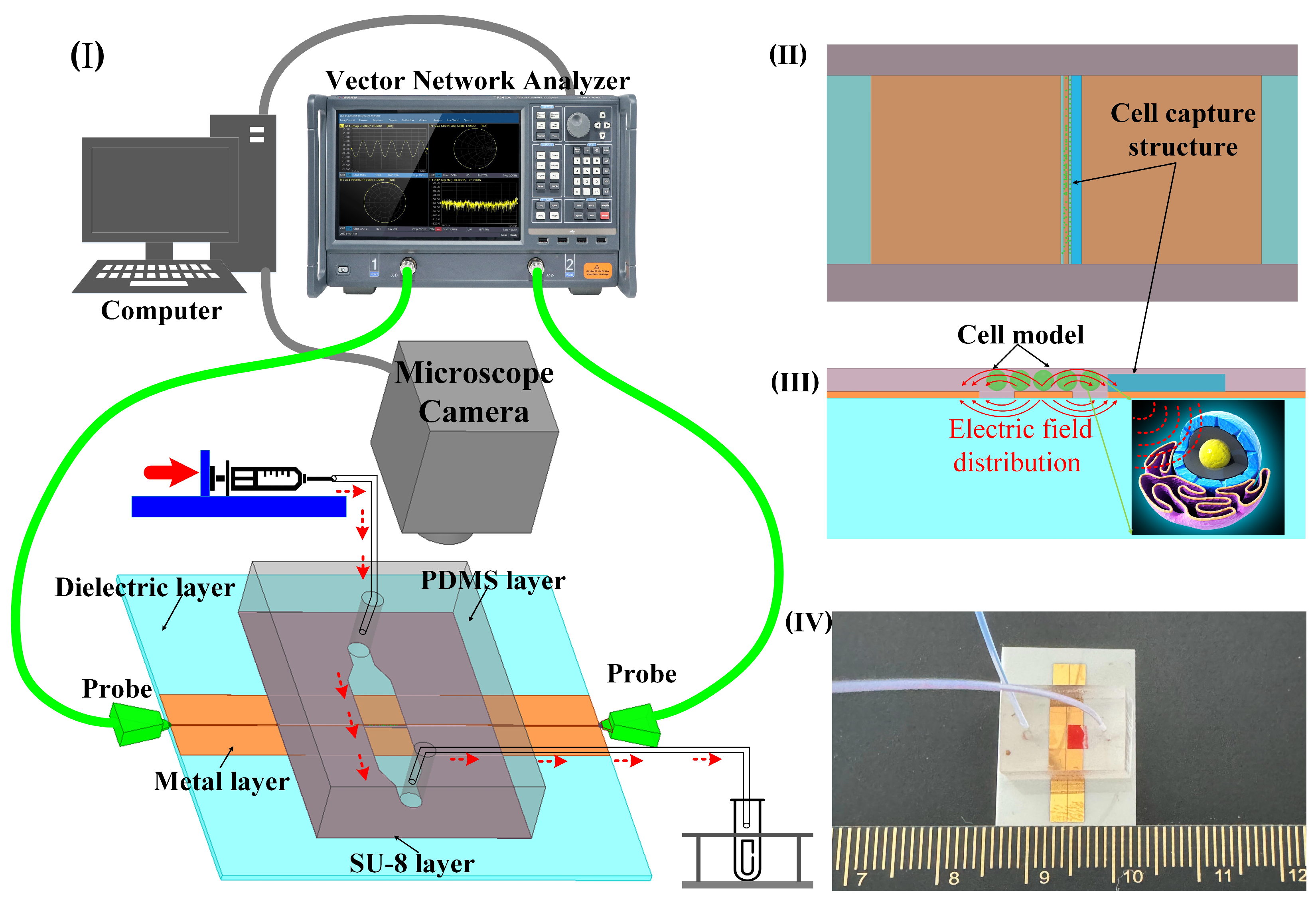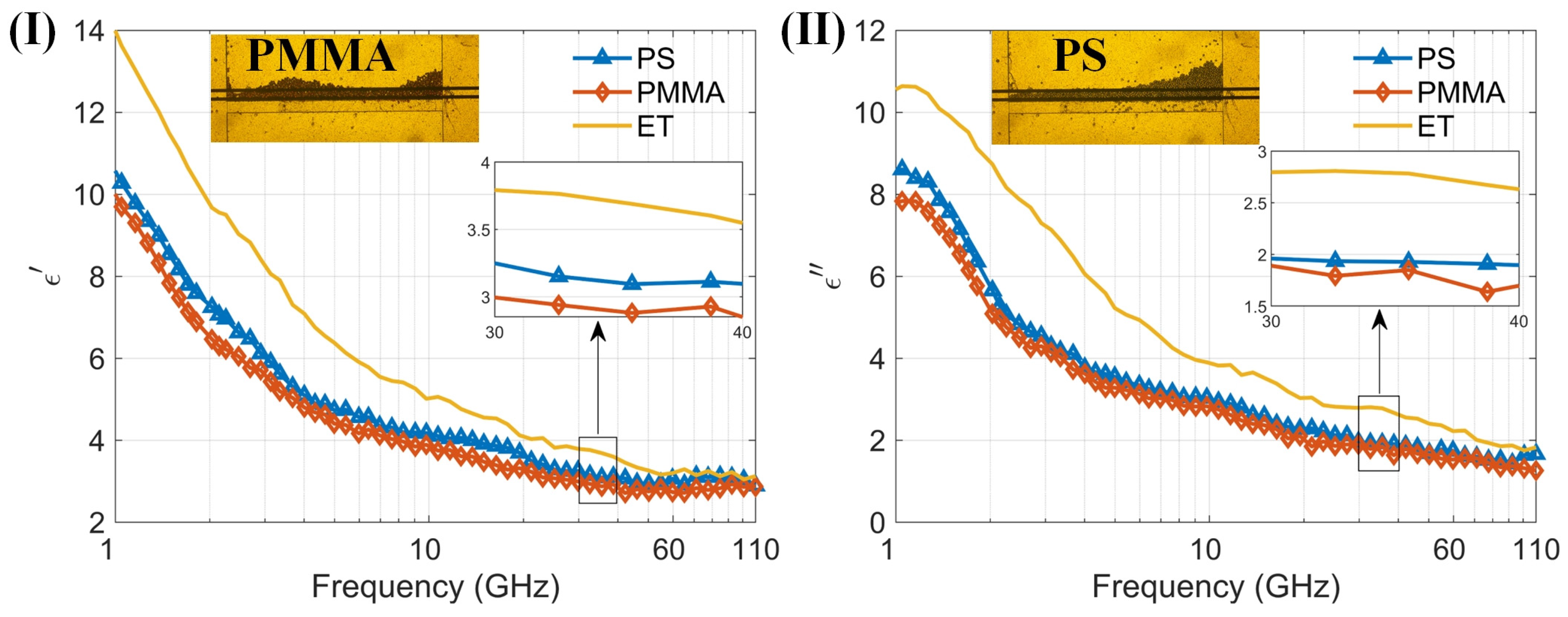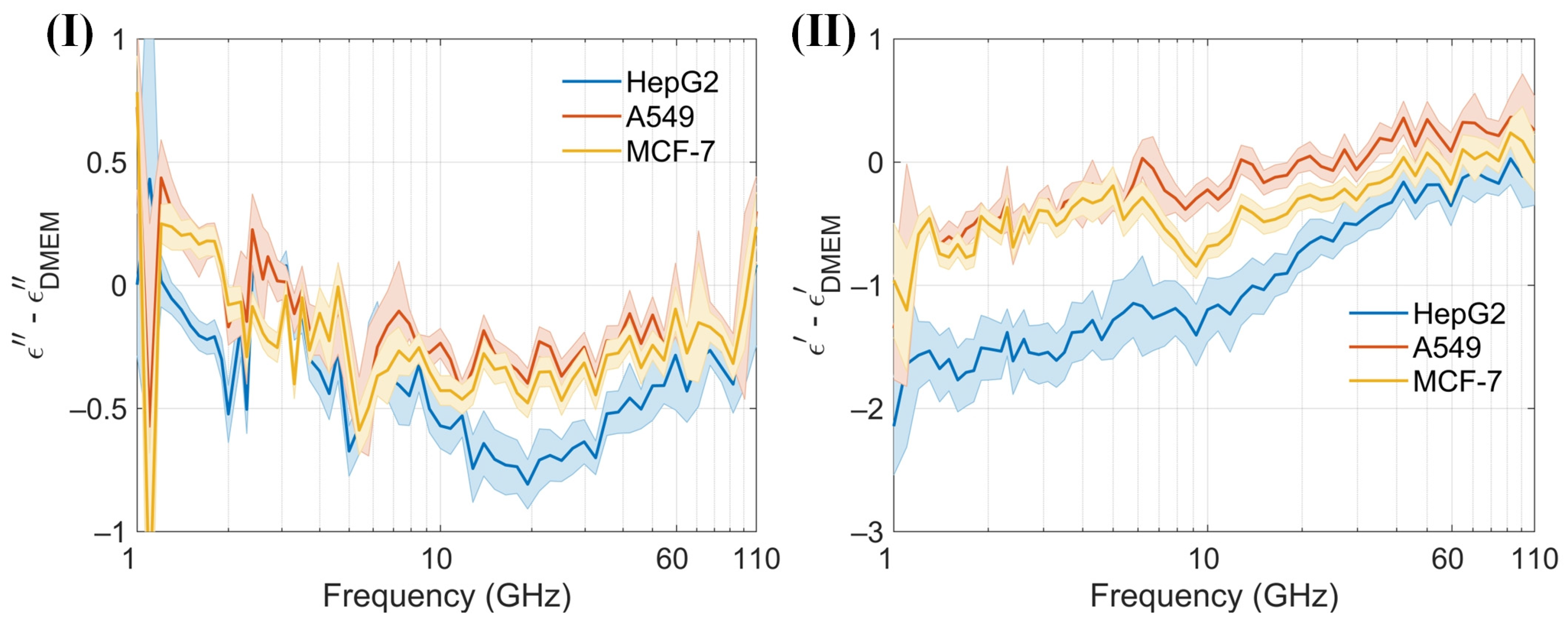Biosensor with Microchannel for Broadband Dielectric Characterization of Nanoliter Cell Suspensions up to 110 GHz
Abstract
:1. Introduction
2. Materials and Methods
2.1. Sensor Design and Manufacture
2.2. Preparation of Cell Samples
2.3. Dielectric Constant Inversion Algorithm
2.4. Construction of Test System and Measurement of Tumor Cells
3. Results and Analysis
3.1. Verification of Feasibility
3.2. Cell Suspension Measurement Results
4. Conclusions
Supplementary Materials
Author Contributions
Funding
Institutional Review Board Statement
Informed Consent Statement
Data Availability Statement
Acknowledgments
Conflicts of Interest
References
- Entesari, K.; Ghiri, R.E.; Kaya, E. Broadband Dielectric Spectroscopy: Recent Developments in Microwave Time-Domain Techniques. IEEE Microw. Mag. 2021, 22, 26–48. [Google Scholar] [CrossRef]
- Hwang, J.C.M. Label-Free Noninvasive Cell Characterization: A Methodology Using Broadband Impedance Spectroscopy. IEEE Microw. Mag. 2021, 22, 78–87. [Google Scholar] [CrossRef]
- Li, Y.; Han, M.; Zhou, W.; Chen, Z. Radio-frequency dielectric relaxation behavior of selected vegetable tissues: Spectra analysis with logarithmic derivative method and simulation with double-shell model. J. Food Eng. 2020, 277, 109914. [Google Scholar] [CrossRef]
- Wang, J.; Fujiwara, O.; Watanabe, S. Approximation of Aging Effect on Dielectric Tissue Properties for SAR Assessment of Mobile Telephones. IEEE Trans. Electromagn. Compat. 2006, 48, 408–413. [Google Scholar] [CrossRef]
- Mirbeik-Sabzevari, A.; Tavassolian, N. Characterization and Validation of the Slim-Form Open-Ended Coaxial Probe for the Dielectric Characterization of Biological Tissues at Millimeter-Wave Frequencies. IEEE Microw. Wirel. Compon. Lett. 2018, 28, 85–87. [Google Scholar] [CrossRef]
- Mirbeik-Sabzevari, A.; Tavassolian, N. Ultrawideband, Stable Normal and Cancer Skin Tissue Phantoms for Millimeter-Wave Skin Cancer Imaging. IEEE Trans. Biomed. Eng. 2019, 66, 176–186. [Google Scholar] [CrossRef] [PubMed]
- Lazebnik, M.; Popovic, D.; McCartney, L.; Watkins, C.B.; Lindstrom, M.J.; Harter, J.; Sewall, S.; Ogilvie, T.; Magliocco, A.; Breslin, T.M.; et al. A large-scale study of the ultrawideband microwave dielectric properties of normal, benign and malignant breast tissues obtained from cancer surgeries. Phys. Med. Biol. 2007, 52, 6093–6115. [Google Scholar] [CrossRef]
- Saeed, K.; Pollard, R.D.; Hunter, I.C. Substrate Integrated Waveguide Cavity Resonators for Complex Permittivity Characterization of Materials. IEEE Trans. Microw. Theory Tech. 2008, 56, 2340–2347. [Google Scholar] [CrossRef]
- Wang, L.; Zhou, R.; Xin, H. Microwave (8–50 GHz) Characterization of Multiwalled Carbon Nanotube Papers Using Rectangular Waveguides. IEEE Trans. Microw. Theory Tech. 2008, 56, 499–506. [Google Scholar] [CrossRef]
- Baghelani, M. Wide-Band Label-Free Selective Microwave Resonator-Based Sensors for Multi-Component Liquid Analysis. IEEE Sens. J. 2022, 22, 2128–2134. [Google Scholar] [CrossRef]
- Chavoshi, M.; Martinic, M.; Nauwelaers, B.; Markovic, T.; Schreurs, D. Design of Uncoupled and Cascaded Array of Resonant Microwave Sensors for Dielectric Characterization of Liquids. IEEE Trans. Microw. Theory Tech. 2023, 71, 1687–1695. [Google Scholar] [CrossRef]
- Hamzah, H.; Abduljabar, A.A.; Porch, A. High Q Microwave Microfluidic Sensor Using a Central Gap Ring Resonator. IEEE Trans. Microw. Theory Tech. 2020, 68, 1830–1838. [Google Scholar] [CrossRef]
- Jha, A.K.; Tiwari, N.K.; Akhtar, M.J. Accurate Microwave Cavity Sensing Technique for Dielectric Testing of Arbitrary Length Samples. IEEE Trans. Instrum. Meas. 2021, 70, 1–10. [Google Scholar] [CrossRef]
- Tiwari, N.K.; Jha, A.K.; Singh, S.P.; Jaleel Akhtar, M. Estimation of Broadband Complex Permeability Using SIW Cavity-Based Multimodal Approach. IEEE Trans. Instrum. Meas. 2020, 69, 6571–6581. [Google Scholar] [CrossRef]
- Barmatz, M.B.; Jackson, H.W.; Javeed, A.S.; Jamieson, C.S.; Steinfeld, D.E. An Accurate Radially Stratified Approach for Determining the Complex Permittivity of Liquids in a Cylindrical Microwave Cavity. IEEE Trans. Microw. Theory Tech. 2015, 63, 504–508. [Google Scholar] [CrossRef]
- Osterberg, J.A.; Dahal, N.; Divan, R.; Miller, C.S.; Moline, D.; Caldwell, T.P.; Yu, X.; Harcum, S.W.; Wang, P. Microwave Sensing of Yeast Cell Species and Viability. IEEE Trans. Microw. Theory Tech. 2021, 69, 1875–1886. [Google Scholar] [CrossRef]
- Du, X.; Ferguson, C.; Ma, X.; Cheng, X.; Hwang, J.C.M. Ultra-Wideband Impedance Spectroscopy of the Nucleus in a Live Cell. IEEE J. Electromagn. RF Microw. Med. Biol. 2022, 6, 267–272. [Google Scholar] [CrossRef]
- Feng, Y.; Huang, L.; Zhao, P.; Liang, F.; Wang, W. A Microfluidic Device Integrating Impedance Flow Cytometry and Electric Impedance Spectroscopy for High-Efficiency Single-Cell Electrical Property Measurement. Anal. Chem. 2019, 91, 15204–15212. [Google Scholar] [CrossRef]
- Ma, X.; Du, X.; Li, L.; Ladegard, C.; Cheng, X.; Hwang, J.C.M. Broadband Electrical Sensing of a Live Biological Cell with In Situ Single-Connection Calibration. Sensors 2020, 20, 3844. [Google Scholar] [CrossRef]
- Ning, Y.; Multari, C.; Luo, X.; Palego, C.; Cheng, X.; Hwang, J.C.M.; Denzi, A.; Merla, C.; Apollonio, F.; Liberti, M. Broadband Electrical Detection of Individual Biological Cells. IEEE Trans. Microw. Theory Tech. 2014, 62, 1905–1911. [Google Scholar] [CrossRef]
- Spencer, D.; Morgan, H. High-Speed Single-Cell Dielectric Spectroscopy. ACS Sens. 2020, 5, 423–430. [Google Scholar] [CrossRef] [PubMed]
- Watts, C.; Hanham, S.M.; Armstrong, J.P.K.; Ahmad, M.M.; Stevens, M.M.; Klein, N. Microwave Dielectric Sensing of Free-Flowing, Single, Living Cells in Aqueous Suspension. IEEE J. Electromagn. RF Microw. Med. Biol. 2020, 4, 97–108. [Google Scholar] [CrossRef]
- Subramanian, N.; Kanwar, J.R.; Athalya, P.k.; Janakiraman, N.; Khetan, V.; Kanwar, R.K.; Eluchuri, S.; Krishnakumar, S. EpCAM aptamer mediated cancer cell specific delivery of EpCAM siRNA using polymeric nanocomplex. J. Biomed. Sci. 2015, 22, 4. [Google Scholar] [CrossRef] [PubMed]
- Hao, P.-P.; Lee, M.-J.; Yu, G.-R.; Kim, I.-H.; Cho, Y.-G.; Kim, D.-G. Isolation of EpCAM+/CD133- Hepatic Progenitor Cells. Mol. Cells 2013, 36, 424–431. [Google Scholar] [CrossRef] [PubMed]
- Shen, H.; Yang, J.; Chen, Z.; Chen, X.; Wang, L.; Hu, J.; Ji, F.; Xie, G.; Feng, W. A novel label-free and reusable electrochemical cytosensor for highly sensitive detection and specific collection of CTCs. Biosens. Bioelectron. 2016, 81, 495–502. [Google Scholar] [CrossRef] [PubMed]
- Ma, X.; Du, X.; Li, H.; Cheng, X.; Hwang, J.C.M. Ultra-Wideband Impedance Spectroscopy of a Live Biological Cell. IEEE Trans. Microw. Theory Tech. 2018, 66, 3690–3696. [Google Scholar] [CrossRef]
- Du, X.; Ladegard, C.; Ma, X.; Cheng, X.; Hwang, J.C.M. Broadband Electrical Sensing of Nucleus Size in a Live Cell From 900 Hz to 40 GHz. In Proceedings of the 2020 IEEE MTT-S International Microwave Biomedical Conference (IMBioC), Virtual, 14–17 December 2020. [Google Scholar]
- Secme, A.; Tefek, U.; Sari, B.; Pisheh, H.S.; Uslu, H.D.; Çalışkan, Ö.A.; Kucukoglu, B.; Erdogan, R.T.; Alhmoud, H.; Sahin, O.; et al. High-Resolution Dielectric Characterization of Single Cells and Microparticles Using Integrated Microfluidic Microwave Sensors. IEEE Sens. J. 2023, 23, 6517–6529. [Google Scholar] [CrossRef]
- Mariam, H.; Poulichet, P.; Takhedmit, H.; Deshours, F.; Richalot, E.; Francais, O. Accurate Characterization by Dielectric Spectroscopy up to 25 GHz of Nano-Liter Range Liquid Volume Within a Microfluidic Channel. IEEE Sens. J. 2022, 22, 3553–3564. [Google Scholar] [CrossRef]
- Booth, J.C.; Orloff, N.D.; Mateu, J.; Janezic, M.; Rinehart, M.; Beall, J.A. Quantitative Permittivity Measurements of Nanoliter Liquid Volumes in Microfluidic Channels to 40 GHz. IEEE Trans. Instrum. Meas. 2010, 59, 3279–3288. [Google Scholar] [CrossRef]
- Bronckers, L.A.; Smolders, A.B. Broadband Material Characterization Method Using a CPW With a Novel Calibration Technique. IEEE Antennas Wirel. Propag. Lett. 2016, 15, 1763–1766. [Google Scholar] [CrossRef]
- Chen, Y.-F.; Wu, H.-W.; Hong, Y.-H.; Lee, H.-Y. 40 GHz RF biosensor based on microwave coplanar waveguide transmission line for cancer cells (HepG2) dielectric characterization. Biosens. Bioelectron. 2014, 61, 417–421. [Google Scholar] [CrossRef] [PubMed]
- Roelvink, J.; Trabelsi, S.; Nelson, S.O. A Planar Transmission-Line Sensor for Measuring the Microwave Permittivity of Liquid and Semisolid Biological Materials. IEEE Trans. Instrum. Meas. 2013, 62, 2974–2982. [Google Scholar] [CrossRef]
- Yang, C.; Ma, J.G. Direct Extraction of Complex Permittivity and Permeability of Materials on a Known-Substrate From Transmission/Reflection Measurements. IEEE Microw. Wirel. Compon. Lett. 2019, 29, 693–695. [Google Scholar] [CrossRef]
- Chen, L.F.; Ong, C.K.; Neo, C.P.; Varadan, V.V.; Varadan, V.K. Microwave Electronics: Measurement and Materials Characterization; John Wiley & Sons: Hoboken, NJ, USA, 2004. [Google Scholar]
- Peyman, A.; Gabriel, C.; Grant, E.H. Complex permittivity of sodium chloride solutions at microwave frequencies. Bioelectromagnetics 2007, 28, 264–274. [Google Scholar] [CrossRef] [PubMed]
- Visco, G.; Dell’Aglio, E.; Tomassetti, M.; Fontanella, L.U.; Sammartino, M.P. An Open-Source, Low-Cost Apparatus for Conductivity Measurements Based on Arduino and Coupled to a Handmade Cell. Analytica 2023, 4, 217–230. [Google Scholar] [CrossRef]
- Behera, K.; Mutharani, B.; Chang, Y.-H.; Kumari, M.; Chiu, F.-C. Protein-Aided Synthesis of Copper-Integrated Polyaniline Nanocomposite Encapsulated with Reduced Graphene Oxide for Highly Sensitive Electrochemical Detection of Dimetridazole in Real Samples. Polymers 2024, 16, 162. [Google Scholar] [CrossRef] [PubMed]
- Barthel, J.; Bachhuber, K.; Buchner, R.; Hetzenauer, H. Dielectric spectra of some common solvents in the microwave region. Water and lower alcohols. Chem. Phys. Lett. 1990, 165, 369–373. [Google Scholar] [CrossRef]
- You, H.R.; Park, J.Y.; Lee, D.H.; Kim, Y.; Choi, J. Recent Research Progress in Surface Ligand Exchange of PbS Quantum Dots for Solar Cell Application. Appl. Sci. 2020, 10, 975. [Google Scholar] [CrossRef]
- Liese, S.; Schlaich, A.; Netz, R.R. Dielectric constant of aqueous solutions of proteins and organic polymers from molecular dynamics simulations. J. Chem. Phys. 2022, 156, 224902. [Google Scholar] [CrossRef] [PubMed]
- Bibi, F.; Villain, M.; Guillaume, C.; Sorli, B.; Gontard, N. A Review: Origins of the Dielectric Properties of Proteins and Potential Development as Bio-Sensors. Sensors 2016, 16, 1232. [Google Scholar] [CrossRef]
- Cho, Y.S.; Gwak, S.-J. Novel Sensing Technique for Stem Cells Differentiation Using Dielectric Spectroscopy of Their Proteins. Sensors 2023, 23, 2397. [Google Scholar] [CrossRef] [PubMed]









| Cell Type | Concentration (106) | Average Diameter | Proportion of Living Cells |
|---|---|---|---|
| A549 | 1.38 | 18 µm | 95% |
| HepG2 | 1.92 | 17.49 µm | 91% |
| MCF-7 | 1.09 | 18.85 µm | 86% |
Disclaimer/Publisher’s Note: The statements, opinions and data contained in all publications are solely those of the individual author(s) and contributor(s) and not of MDPI and/or the editor(s). MDPI and/or the editor(s) disclaim responsibility for any injury to people or property resulting from any ideas, methods, instructions or products referred to in the content. |
© 2024 by the authors. Licensee MDPI, Basel, Switzerland. This article is an open access article distributed under the terms and conditions of the Creative Commons Attribution (CC BY) license (https://creativecommons.org/licenses/by/4.0/).
Share and Cite
Sun, W.; Wang, J.; Chen, J.; Huang, X.; Rao, X.; Su, J.; Huang, Y.; Zhang, B.; Sun, L. Biosensor with Microchannel for Broadband Dielectric Characterization of Nanoliter Cell Suspensions up to 110 GHz. Biosensors 2024, 14, 327. https://doi.org/10.3390/bios14070327
Sun W, Wang J, Chen J, Huang X, Rao X, Su J, Huang Y, Zhang B, Sun L. Biosensor with Microchannel for Broadband Dielectric Characterization of Nanoliter Cell Suspensions up to 110 GHz. Biosensors. 2024; 14(7):327. https://doi.org/10.3390/bios14070327
Chicago/Turabian StyleSun, Wen, Jianhua Wang, Jin Chen, Xiwei Huang, Xin Rao, Jiangtao Su, Yuqiao Huang, Boyu Zhang, and Lingling Sun. 2024. "Biosensor with Microchannel for Broadband Dielectric Characterization of Nanoliter Cell Suspensions up to 110 GHz" Biosensors 14, no. 7: 327. https://doi.org/10.3390/bios14070327
APA StyleSun, W., Wang, J., Chen, J., Huang, X., Rao, X., Su, J., Huang, Y., Zhang, B., & Sun, L. (2024). Biosensor with Microchannel for Broadband Dielectric Characterization of Nanoliter Cell Suspensions up to 110 GHz. Biosensors, 14(7), 327. https://doi.org/10.3390/bios14070327






